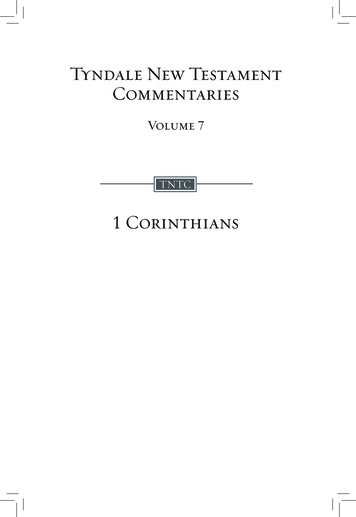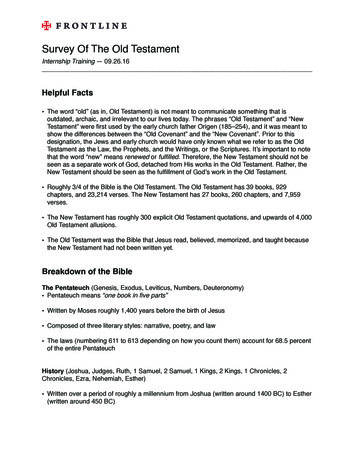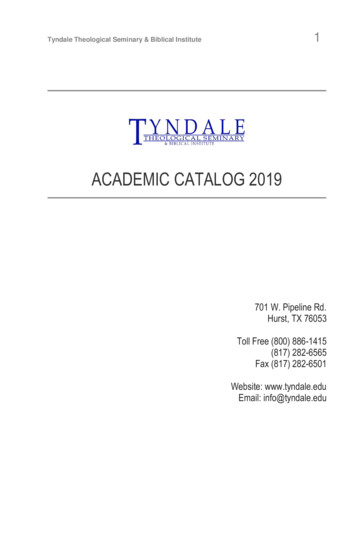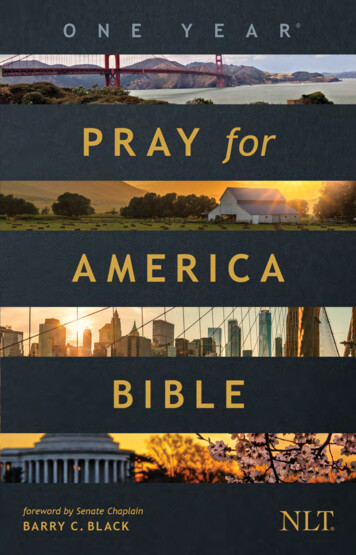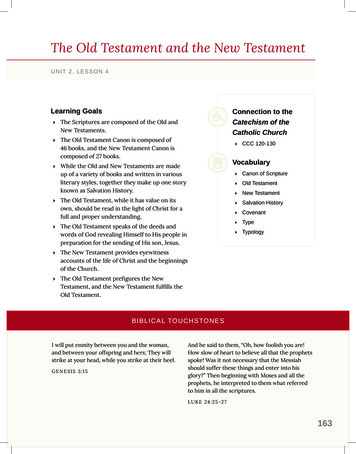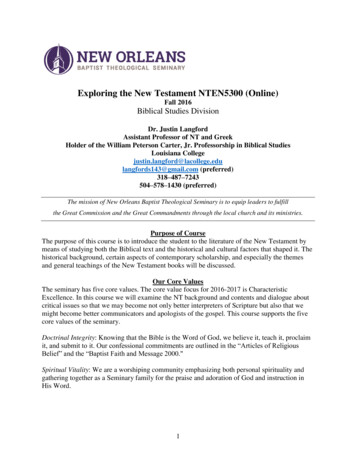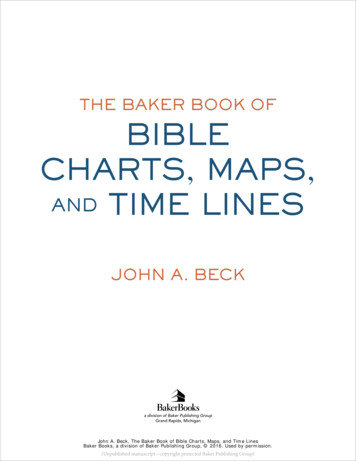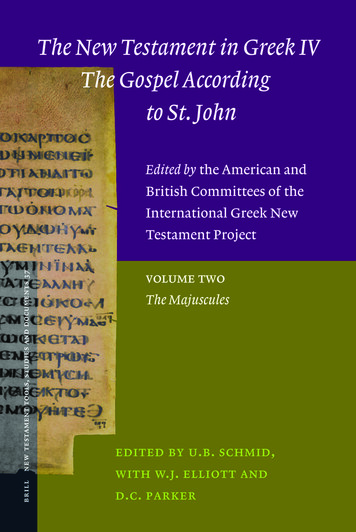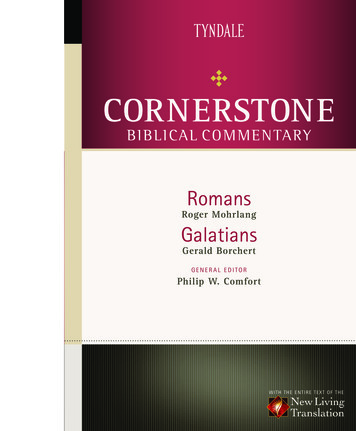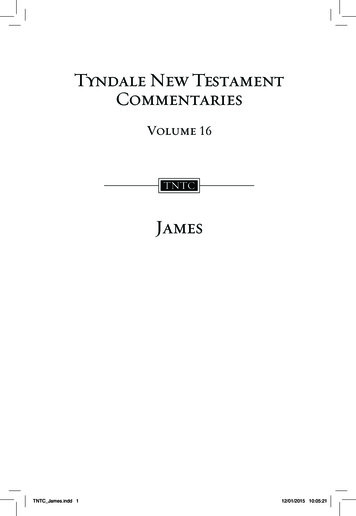
Transcription
Tyndale New TestamentCommentariesVolume 16TNTCJamesTNTC James.indd 112/01/2015 10:05:21
TNTC James.indd 212/01/2015 10:05:21
Tyndale New TestamentCommentariesVolume 16Series Editor: Eckhard J. SchnabelConsulting Editor: Nicholas PerrinJamesAn Introduction and CommentaryDouglas J. MooTNTC James.indd 312/01/2015 10:05:22
InterVarsity Press, USAP.O. Box 1400Downers Grove, IL 60515-1426, USAwww.ivpress.comemail@ivpress.comInter-Varsity Press, EnglandNorton StreetNottingham NG7 3HR, Englandwww.ivpbooks.comivp@ivpbooks.com 2015 by Douglas J. MooDouglas J. Moo has asserted his right under the Copyright, Designs and Patents Act, 1988, to be identified asAuthor of this work.All rights reserved. No part of this book may be reproduced in any form without written permission fromInterVarsity Press.InterVarsity Press , USA, is the book-publishing division of InterVarsity Christian Fellowship/USA and amember movement of the International Fellowship of Evangelical Students. Website: intervarsity.org.Inter-Varsity Press, England, is closely linked with the Universities and Colleges Christian Fellowship, a studentmovement connecting Christian Unions throughout Great Britain, and a member movement of the InternationalFellowship of Evangelical Students. Website: uccf.org.uk.Unless otherwise indicated Scripture quotations are from the Holy Bible, New International Version , niv Copyright 1979, 1984, 2011 by Biblica, Inc. Used by permission. All rights reserved worldwide.First edition 1985Second edition 2015Image: Scala/Art Resource, NYUSA ISBN 978-0-8308-4287-2UK ISBN 978-1-78359-209-8Set in Garamond 11/13ptTypeset in Great Britain by CRB Associates, Potterhanworth, LincolnshirePrinted and bound in Great Britain by Ashford Colour Press Ltd, Gosport, HampshireAs a member of the Green Press Initiative, InterVarsity Press is committed to protecting theenvironment and to the responsible use of natural resources. To learn more, visitgreenpressinitiative.org.Library of Congress Cataloging-in-Publication DataA catalogue record for this book is available from the Library of Congress.British Library Cataloguing in Publication DataA catalogue record for this book is available from the British TNTC James.indd 49218720654191817321611512/01/2015 10:05:23
C O N T ENT S1.2.3.4.5.General prefaceAuthor’s preface to the first editionPreface to the second editionAbbreviationsSelect bibliography79111317Introduction27The letter in the churchAuthorshipCircumstances of the letterThe nature of the letterTheological emphases of the letter2731445055Analysis73Commentary75Additional noteAleiphō and chriō (5:14)TNTC James.indd 522612/01/2015 10:05:23
TNTC James.indd 612/01/2015 10:05:23
G E N ERA L PRE FACEThe Tyndale Commentaries have been a flagship series for evan gelical readers of the Bible for over sixty years. The original NewTestament volumes (1956–1974) as well as the new commentaries(1983–2003) rightly established themselves as a point of firstreference for those who wanted more than is usually offered in aone-volume Bible commentary, without requiring the technical skillsin Greek and in Jewish and Greco-Roman studies of the moredetailed series, and with the advantage of being shorter than thevolumes of intermediate commentary series. The appearance ofnew popular commentary series demonstrates that there is a con tinuing demand for commentaries that appeal to Bible study leadersin churches and at universities. The publisher, editors and authorsof the Tyndale Commentaries believe that the series continues tomeet an important need in the Christian community, not least inwhat we call today the Global South, with its immense growth ofchurches and the corresponding need for a thorough understandingof the Bible by Christian believers.In the light of new knowledge, new critical questions, new revisionsof Bible translations, and the need to provide specific guidance onthe literary context and the theological emphases of the individualpassage, it was time to publish new commentaries in the series. Fourauthors will revise their commentary that appeared in the secondseries. The original aim remains. The new commentaries are neithertoo short nor unduly long. They are exegetical and thus root theinterpretation of the text in its historical context. They do not aimTNTC James.indd 712/01/2015 10:05:23
8 ja m e sto solve all critical questions, but they are written with an awarenessof major scholarly debates which may be treated in the Introduction,in Additional Notes or in the commentary itself. While not specificallyhomiletic in aim, they want to help readers to understand the passageunder consideration in such a way that they begin to see points ofrelevance and application, even though the commentary does notexplicitly offer these. The authors base their exegesis on the Greektext, but they write for readers who do not know Greek; Hebrew andGreek terms that are discussed are transliterated. The English trans lation used for the first series was the Authorized (King James)Version, while the volumes of the second series mostly used theRevised Standard Version; the volumes of the third series use eitherthe New International Version (2011) or the New Revised StandardVersion as primary versions, unless otherwise indicated by the author.An immense debt of gratitude for the first and second seriesof the Tyndale Commentaries was owed to R. V. G. Tasker andL. Morris, who each wrote four of the commentaries themselves.The recruitment of new authors for the third series proved to beeffortless, as colleagues responded enthusiastically to be involved inthis project, a testimony both to the larger number of New Testamentscholars capable and willing to write commentaries, to the widerethnic identity of contributors, and to the role that the TyndaleCommentaries have played in the church worldwide. It continues tobe the hope of all those concerned with this series that God willgraciously use the new commentaries to help readers understand asfully and clearly as possible the meaning of the New Testament.Eckhard J. Schnabel, Series EditorNicholas Perrin, Consulting EditorTNTC James.indd 812/01/2015 10:05:23
AU T HOR’ S PRE FACE T O T H E F IRSTE D IT IONMy first sermon, delivered to a long-suffering professor and fourfellow novice preachers, was on James 1:22–25. I thought that James’emphasis on the need to do the word was important in a seminarycontext, where all too easily the Scripture becomes a book to beanalysed rather than a message to be obeyed. That the message wasneeded then is certain; that it is still urgently required is equallycertain – and not only in seminaries. All across the world, peopleare awakening to biblical Christianity. Third World churches areburgeoning, American ‘evangelicalism’ continues to attract muchattention, and European Christians are seeing renewal and a newevangelistic concern. Yet the personal and social transformationsthat should accompany such revival are, very often, sadly lacking.Why is this? Surely one of the main reasons is that the simple pleaof James – ‘do the word’ – is not being heeded. The Bible is beingtranslated, commented on, read, studied, preached and analysed asnever before. But it is questionable whether it is being obeyed to acomparable degree.All this suggests that the message of James is one that we all needto hear – and obey. No profound theologian, James’ genius lies inhis profound moral earnestness; in his powerfully simple call forrepentance, for action, for a consistent Christian lifestyle. His wordsneed to thrust through our theological debates, our personal pre conceptions, our spiritual malaise, and set us back on the road to abiblical, invigorating, transforming Christianity.TNTC James.indd 912/01/2015 10:05:23
10 ja m e sI owe thanks to many people who helped in making this commen tary possible. Dr Leon Morris has been an encouraging yet eagle-eyededitor. Trinity Evangelical Divinity School, where I teach, hasgraciously provided secretarial time – and Luann Kuehl has had theperplexing (and sometimes amusing) job of deciphering my hand writing. Students here at Trinity and in several churches have, withtheir papers, questions and comments, greatly influenced my under standing of the letter. My five children have been a source of diversion(not always wanted!), personal renewal and joy. Most of all, my wifeJenny has both encouraged me in the work and, by commenting onthe whole manuscript carefully, immeasurably improved both its styleand its content. It is to her I dedicate the book.Douglas J. MooTNTC James.indd 1012/01/2015 10:05:23
P R E FACE T O T HE S E CO ND EDITIONI am grateful for the opportunity to return, after almost thirty years,to the first book I wrote and to bring it up to date for a new gener ation of believers. Differences from the older edition consist in theaddition of some of the important books and articles on Jamespublished since 1985, improvement in style, and a few tweaks inmy interpretive conclusions. I appreciate the editing assistance of mycolleague Nick Perrin and former colleague Eckhard Schnabel. Andtwo of my PhD students at Wheaton, Mike Kibbe and Ben Dally,have provided very valuable bibliographic and editing assistance.As was the case in the first edition, I dedicate this new version tomy wife, Jenny.TNTC James.indd 1112/01/2015 10:05:23
TNTC James.indd 1212/01/2015 10:05:23
C HIE F A B B RE V I AT I O NSAB Anchor BibleANRW Aufstieg und Niedergang der römischen Welt, ed. W. Haaseand H. Temporini (Berlin: de Gruyter, 1972–)Ant. Josephus, AntiquitiesAusBibRev Australian Biblical ReviewBDAG A Greek–English Lexicon of the New Testament and OtherEarly Christian Literature, ed. W. Bauer, F. W. Danker,W. F. Arndt and F. W. Gingrich, 3rd ed. (Chicago:University of Chicago Press, 2000)BDF A Grammar of the New Testament and Other EarlyChristian Literature, ed. F. Blass, A. Debrunner andR. W. Funk (Chicago: University of Chicago Press,1961; reprint 1982)BECNT Baker Exegetical Commentary on the New TestamentBib BiblicaBNTC Black’s New Testament CommentariesBSac Bibliotheca SacraBZ Biblische ZeitschriftCBQ Catholic Biblical QuarterlyCBR Currents in Biblical ResearchDLNTD Dictionary of the Later New Testament and ItsDevelopments, ed. P. H. Davids and R. P. Martin(Downers Grove: InterVarsity Press; Leicester:Inter-Varsity Press, 1997)EQ Evangelical QuarterlyTNTC James.indd 1312/01/2015 10:05:23
14 ja m e sExpT Expository TimesH.E. Eusebius, Historia EcclesiasticaHer HermeneiaHTKNT Herders Theologischer Kommentar zum NeuenTestamentHTR Harvard Theological ReviewHUT Hermeneutische Untersuchungen zur TheologieICC International Critical CommentaryIRM International Review of MissionISBE The International Standard Bible Encyclopedia, ed. G. W.Bromiley (Grand Rapids: Eerdmans, 1979–1988)JBL Journal of Biblical LiteratureJR Journal of ReligionJSNTSup Journal for the Study of the New TestamentSupplement seriesJTS Journal of Theological StudiesLW Luther’s Works, ed. J. Pelikan and H. T. Lehmann,55 vols. (St Louis: Concordia; Philadelphia: Fortress,1955–1986)lxx Septuagint; English translations of LXX passagesare taken from Albert Pietersma and BenjaminG. Wright, eds., A New English Translation of theSeptuagint (Oxford: Oxford University Press, 2007)MM The Vocabulary of the Greek New Testament Illustrated fromthe Papyri and Other Non-Literary Sources, ed. J. H.Moulton and G. Milligan (Grand Rapids: Eerdmans,1930 1982)NAC New American CommentaryNICNT New International Commentary on the NewTestamentNIDNTT The New International Dictionary of New TestamentTheology, ed. C. Brown (Grand Rapids: Eerdmans,1975–1978)NIGTC New International Greek Testament CommentaryNIVAC New International Version ApplicationCommentaryNovT Novum TestamentumNTS New Testament StudiesTNTC James.indd 1412/01/2015 10:05:23
c h i e f a b b r e v i a t i o n s 15OTNT Ökumenischer Taschenbuchkommentar zum NeuenTestamentPhillips J. B. Phillips, The New Testament in Modern English(1958)PNTC Pillar New Testament CommentaryRHPR Revue d’histoire et de philosophie religieusesSNTSMS Society for New Testament Studies MonographSeriesTDNT Theological Dictionary of the New Testament, ed. G. Kitteland G. Friedrich (Grand Rapids: Eerdmans,1964–1976)TNTC Tyndale New Testament CommentaryTrinJ Trinity JournalTynBul Tyndale BulletinWBC Word Biblical CommentaryWTJ Westminster Theological JournalWUNT Wissenschaftliche Untersuchungen zum NeuenTestamentZECNT Zondervan Exegetical Commentary on the NewTestamentZNW Zeitschrift für die neutestamentliche WissenschaftBible Versionsceb Common English Bible (2010)esv English Standard Version (2007)gnb Good News Bible (1990; Today’s English Version)hcsb Holman Christian Standard Bible (2010)kjv King James Versionnab New American Bible (2011)nasb New American Standard Bible (1995)neb New English Bible (Old Testament, 1970; NewTestament2, 1970)net New English Translation (2006)niv New International Version (2011)njb New Jerusalem Bible (1985)nlt New Living Translation (1996)nrsv New Revised Standard Version (1989)TNTC James.indd 1512/01/2015 10:05:23
16 ja m e sreb Revised English Bible (1989)rsv Revised Standard Version (1971 New TestamentSecond Edition)Quotations from Philo are taken from the Loeb Classical Libraryedition of the Works of Philo. The Apocrypha is cited from thenrsv translation. The Pseudepigrapha is cited from the translationedited by J. H. Charlesworth, The Old Testament Pseudepigrapha, 2 vols.(New York: Doubleday, 1983, 1985).TNTC James.indd 1612/01/2015 10:05:23
SE LE CT B I B LI O GRA PHYCommentaries on JamesAdam, A. K. M. (2013), James: A Handbook on the Greek Text (Waco:Baylor University Press).Adamson, J. B. (1976), The Epistle of James, NICNT (Grand Rapids:Eerdmans).Allison, D. C., Jr. (2013), A Critical and Exegetical Commentary on theEpistle of James, ICC (London: Bloomsbury T. & T. Clark).Beasley-Murray, G. R. (1965), The General Epistles: James, 1 Peter, Judeand 2 Peter (New York: Abingdon).Bengel, J. A. (1860), Gnomon of the New Testament, 5 vols., 3rd edn(Edinburgh: T. & T. Clark).Blomberg, C. L., and M. J. Kamell (2008), James, ZECNT (GrandRapids: Zondervan).Brosend, W. F., II (2004), James and Jude, The New CambridgeBible Commentary (Cambridge: Cambridge University Press).Burdick, D. W. (1981), ‘James’, in The Expositor’s Bible Commentary,Vol. 12 (Grand Rapids: Zondervan).Calvin, J. (1855), Commentaries on the Catholic Epistles, trans. J. Owen,repr. 1948 (Grand Rapids: Eerdmans).Cantinat, J. (1973), Les Épîtres de Saint Jacques et de Saint Jude (Paris:Gabalda).Chaine, J. (1927), L’Épître de Saint Jacques (Paris: Gabalda).Davids, P. (1982), The Epistle of James, NIGTC (Grand Rapids:Eerdmans).TNTC James.indd 1712/01/2015 10:05:23
18 ja m e sDibelius, M. (1976), A Commentary on the Epistle of James, rev. ednby H. Greeven (Philadelphia: Fortress).Doriani, D. M. (2007), James, Reformed Expository Commentary(Phillipsburg: Presbyterian & Reformed).Frankemölle, H. (1994), Der Brief des Jakobus, OTNT (Gütersloh:Gütersloher).Hiebert, D. E. (1992), James, rev. edn (Chicago: Moody).Hort, F. J. A. (1909), The Epistle of St. James (London: Macmillan).Huther, J. E. (1887), Critical and Exegetical Handbook to the GeneralEpistles of James, Peter, John and Jude (New York: Funk &Wagnalls).Johnson, L. T. (1995), The Letter of James, AB 37a (Garden City:Doubleday).Knowling, R. J. (1910), The Epistle of St. James (London: Methuen).Laws, S. (1980), A Commentary on the Epistle of James, BNTC (NewYork: Harper & Row).Martin, R. P. (1988), James, WBC 48 (Waco: Word, 1988).Mayor, J. B. (1913), The Epistle of St. James, 2nd edn (London:Macmillan).McCartney, D. G. (2009), James, BECNT (Grand Rapids: Baker).McKnight, S. (2011), The Letter of James, NICNT (Grand Rapids:Eerdmans).Mitton, C. L. (1966), The Epistle of James (Grand Rapids:Eerdmans).Moffat, J. (1928), The General Epistles of James, Peter and Jude(London: Hodder & Stoughton).Moo, D. J. (1985), The Letter of James, TNTC (Leicester: Inter-VarsityPress).(2000), The Letter of James, PNTC (Grand Rapids: Eerdmans).Mußner, F. (1981), Der Jakobusbrief, 4th edn, HTKNT (Freiburg:Herder).Nystrom, D. P. (1997), James, NIVAC (Grand Rapids: Zondervan).Reicke, B. (1964), The Epistles of James, Peter and Jude, AB 37(Garden City: Doubleday).Richardson, K. A. (1997), James, NAC 36 (Nashville: Broadman& Holman).Ropes, J. H. (1916), A Critical and Exegetical Commentary on theEpistle of St. James, ICC (Edinburgh: T. & T. Clark).TNTC James.indd 1812/01/2015 10:05:23
s e l e c t b i b l i o g r a p h y 19Ross, A. (1954), The Epistles of James and John (London: Marshall,Morgan & Scott).Schlatter, A. (1956), Der Brief des Jakobus (Stuttgart: Calwer).Tasker, R. V. G. (1956), The General Epistle of James, TNTC (GrandRapids: Eerdmans).Varner, W. (2010), The Book of James: A New Perspective (Woodlands:Kress Biblical Resources [accessed through Logos BibleSoftware]).Vlachos, C. A. (2013), James, Exegetical Guide to the GreekNew Testament (Nashville: Broadman & Holman).Vouga, F. (1984), L’Épître de Saint Jacques (Geneva: Labor etFides).Windisch, H. (1951), Die katholischen Briefe (Tübingen: MohrSiebeck).Other worksAmerding, C. (1938), ‘Is Any Among You Afflicted: A Study ofJames 5:13–20’, BSac 95, pp. 195–201.Amphoux, C. B. (1970), ‘À propos de Jacques 1,17’, RHPR 50,pp. 127–136.—— (1978), ‘Une relecture du chapitre 1 de Jacques’, Biblica 59,pp. 554–561.Baasland, E. (1988), ‘Literarische Form, Thematik undgeschichtliche Einordnung des Jakobusbriefes’, ANRW II.25.5,pp. 3646–3684.Baker, W. R. (1985), Personal Speech-Ethics in the Epistle of James,WUNT 2/68 (Tübingen: Mohr Siebeck).(2008), ‘Searching for the Holy Spirit in the Epistle ofJames: Is “Wisdom” Equivalent?’ TynBul 59, pp. 293–315.Baly, D. (1974), The Geography of the Bible (New York: Harper &Row).Barclay, W. (1976), The Letters of James and Peter (Philadelphia:Westminster John Knox).Bauckham, R. (1990), Jude and the Relatives of Jesus in the EarlyChurch (Edinburgh: T. & T. Clark).(1999), James: Wisdom of James, Disciple of Jesus the Sage(London: Routledge).TNTC James.indd 1912/01/2015 10:05:23
20 ja m e s(2004), ‘The Spirit of God in Us Loathes Envy’, in G. N.Stanton, B. W. Longenecker and S. C. Barton (eds.), The HolySpirit and Christian Origins: Essays in Honor of James D. G. Dunn(Grand Rapids: Eerdmans), pp. 270–281.(2008), Jesus and the God of Israel: God Crucified and Other Studieson the New Testament’s Christology of Divine Identity (Grand Rapids:Eerdmans).Beale, G. K. (2011), New Testament Biblical Theology (Grand Rapids:Baker).Berkhof, H. (1979), Christian Faith (Grand Rapids: Eerdmans).Blomberg, C. L. (1999), Neither Poverty Nor Riches: A BiblicalTheology of Material Possessions, New Studies in Biblical Theology(Leicester: Apollos).(2013), Christians in an Age of Wealth: A Biblical Theology ofStewardship (Grand Rapids: Zondervan).Brown, R. E. (1997), An Introduction to the New Testament (NewYork: Doubleday).Bruce, F. F. (1979), Peter, Stephen, James and John: Studies in NonPauline Christianity (Grand Rapids: Eerdmans).Burkitt, F. C. (1924), Christian Beginnings (London: University ofLondon).Cadoux, A. T. (1944), The Thought of St. James (London: JamesClarke).Calvin, J. (1960), The Institutes of the Christian Religion, 2 vols.(Philadelphia: Westminster).Cargal, T. (1993), Restoring the Diaspora: Discursive Structure andPurpose in the Epistle of James (Atlanta: Scholars).Carpenter, C. B. (2001), ‘James 4.5 Reconsidered’, NTS 47,pp. 189–205.Carson, D. A. (2007), ‘James’, in G. K. Beale and D. A. Carson(eds.), Commentary on the New Testament Use of the Old Testament(Grand Rapids: Baker).and D. J. Moo (2005), An Introduction to the New Testament,rev. edn (Grand Rapids: Zondervan).Chester, A. and R. Martin (1994), The Theology of the Letters of James,Peter, and Jude (Cambridge: Cambridge University Press).Crotty, R. B. (1992), ‘The Literary Structure of the Letter ofJames’, AusBibRev 40, pp. 47–48.TNTC James.indd 2012/01/2015 10:05:23
s e l e c t b i b l i o g r a p h y 21Deppe, D. B. (1990), ‘The Sayings of Jesus in the Paraenesis ofJames: A PDF Revision of the Doctoral Dissertation “TheSayings of Jesus in the Epistle of James” ’ (University ofAmsterdam) f.jesus.in.the.paranaesis.of.james. pdf).Donelson, L. R. (1986), Pseudepigraphy and Ethical Argument in thePastoral Epistles, HUT 22 (Tübingen: Mohr Siebeck).Donker, C. (1981), ‘Der Verfasser des Jakobus und sein Gegner’,ZNW 72, pp. 227–240.Dunn, J. D. G. (1977), Unity and Diversity in the New Testament:An Inquiry into the Character of Earliest Christianity (Philadelphia:Fortress).(1998), The Theology of Paul the Apostle (Grand Rapids:Eerdmans).Eichholz, G. (1961), Glaube und Werk bei Paulus und Jakobus(Munich: Kaiser).Elliott-Bins, L. (1955), ‘The Meaning of ’YLH in James III.5’,NTS 2, pp. 48–50.Francis, F. O. (1970), ‘The Form and Function of the Opening andClosing Paragraphs of James and 1 John’, ZNW 6, pp. 110–126.Geyser, A. S. (1975), ‘The Letter of James and the SocialCondition of His Addressees’, Neotestamentica 9, pp. 25–33.Goppelt, L. (1975, 1976), Theology of the New Testament, 2 vols.(Grand Rapids: Eerdmans).Gunter, J. J. (1974), ‘The Family of Jesus’, EQ 46, pp. 25–41.Guthrie, D. (1990), New Testament Introduction (Downers Grove:InterVarsity Press).Hadidian, D. Y. (1951–52), ‘Palestinian Pictures in the Epistle ofJames’, ExpT 63, pp. 227–228.Hagner, D. A. (2012), The New Testament: A Historical and TheologicalIntroduction (Grand Rapids: Baker).Harland, P. A. (2002), ‘The Economy of First-Century Palestine:State of the Scholarly Discussion’, in J. Blasi, P.-T. AndréTurcotte and J. Duhaime (eds.), Handbook of Early Christianity:Social Science Approaches (Walnut Creek, Calif.: Alta Mira Press),pp. 511–527.Hartin, P. J. (1991), James and the Q Sayings of Jesus, JSNTSup 47(Sheffield: JSOT).TNTC James.indd 2112/01/2015 10:05:23
22 ja m e sHayden, D. R. (1981), ‘Calling the Elders to Pray’, BSac 138,pp. 258–286.Hengel, M. (1974), Judaism and Hellenism, 2 vols. (Philadelphia:Fortress).Hodges, Z. (1963), ‘Light on James Two from Textual Criticism’,BSac 120, pp. 341–350.Hoppe, R. (1977), Der theologische Hintergrund des Jakobusbriefes(Würzburg: Echter).Hunter, A. M. (1972), Introducing the New Testament (Louisville:Westminster John Knox).Johnson, L. T. (1982), ‘The Use of Leviticus 19 in the Letter ofJames’, JBL 101, pp. 391–401.(1983), ‘James 3:13 – 4:10 and the Topos ΠΕΡΙ ΦΘΟΝΟΥ’,NovT 25, pp. 327–347.(2004), Brother of Jesus, Friend of God: Studies in the Letter of James(Grand Rapids: Eerdmans).(2010), The Writings of the New Testament, 3rd edn(Minneapolis: Fortress).Judge, E. A. (1980), ‘The Social Identity of the First Christians:A Question of Method in Religious History’, Journal of ReligiousHistory 11, pp. 201–217.Kidner, D. (1985), The Wisdom of Proverbs, Job, and Ecclesiastes(Downers Grove: InterVarsity Press).Kirk, J. A. (1969), ‘The Meaning of Wisdom in James:Examination of a Hypothesis’, NTS 16, pp. 24–38.Kittel, G. (1942), ‘Der geschichtliche Ort des Jacobusbriefes’,ZNW 41, pp. 71–105.Klein, M. (1995), ‘Ein vollkommenes Werk.’ Vollkommenheit, Gesetzund Gericht als theologische Themen des Jakobusbriefes (Stuttgart:Kohlhammer).Kümmel, W. G. (1975), Introduction to the New Testament, rev. edn(Nashville: Abingdon).Laato, T. (1997), ‘Justification According to James: A Comparisonwith Paul’, TrinJ 18, pp. 47–61.(2003), Rechtfertigung bei Jakobus: Ein Vergleich mit Paulus(Saarijärvi: Gummerus Kirjapaino).Ladd, G. E. (1993), A Theology of the New Testament, rev. edn byD. A. Hagner (Grand Rapids: Eerdmans).TNTC James.indd 2212/01/2015 10:05:23
s e l e c t b i b l i o g r a p h y 23Laws, S. (1974), ‘Does Scripture Speak in Vain? A Reconsiderationof James IV.5’, NTS 30, pp. 210–215.Lightfoot, J. B. (1881), Saint Paul’s Epistle to the Galatians: A RevisedText with Introduction, Notes, and Dissertations (London:Macmillan).MacDonald, L. M. and S. E. Porter (2000), Early Christianity andIts Sacred Literature (Peabody, Mass.: Hendrickson).MacMullen, R. (1974), Roman Social Relations: 50 B.C. to A.D. 284(New Haven: Yale University Press).Marshall, I. H. (1978), The Gospel of Luke, NIGTC (Grand Rapids:Eerdmans).(2004), New Testament Theology: Many Witnesses, One Gospel(Downers Grove: InterVarsity Press).Martin, R. P. (1978), ‘The Life-Setting of the Epistle of James inthe Light of Jewish History’, in G. Tuttle (ed.), Biblical and NearEastern Studies: Essays in Honor of Sanford LaSor (Grand Rapids:Eerdmans), pp. 97–103.Massebieau, L. (1895), ‘L’Épître de Jacques – est-elle l’oeuvre d’unChrétien?’, Revue de l’histoire des religions 32, pp. 249–283.Maynard-Reid, P. W. (1987), Poverty and Wealth in James (Maryknoll,NY: Orbis).Mayordomo-Marin, M. (1992), ‘Jak 5,2.3a: Zukünftiges Gerichtoder gegenwärtiger Zustand?’, ZNW 83, pp. 132–137.Meade, D. G. (1986), Pseudonymity and Canon: An Investigation intothe Relationship of Authorship and Authority in Jewish and EarliestChristian Tradition, WUNT 2/39 (Tübingen: Mohr Siebeck).Meinertz, M. (1932), ‘Die Krankensalbung Jak. 5.14f.’, BZ 20,pp. 23–36.Metzger, B. M. (1998), A Textual Commentary on the Greek NewTestament, 2nd rev. edn (New York: United Bible Societies).Meyer, A. (1930), Das Rätsel des Jacobusbriefes (Berlin: Töpelmann).Moo, D. J. (1988), ‘Divine Healing in the Health and WealthGospel’, TrinJ 9, pp. 191–209.(2013a), Galatians, BECNT (Grand Rapids: Baker).(2013b), ‘Genesis 15:6 in the New Testament’, in D. M.Gurtner and B. L. Gladd (eds.), From Creation to New Creation:Biblical Theology and Exegesis. Essays in Honor of G. K. Beale(Peabody, Mass.: Hendrickson), pp. 147–162.TNTC James.indd 2312/01/2015 10:05:23
24 ja m e sMoule, C. F. D. (1971), An Idiom Book of New Testament Greek(Cambridge: Cambridge University Press).Ng, E. Y. L. (2003), ‘Father-God Language and Old TestamentAllusions in James’, TynBul 54, pp. 41–54.Nienhuis, D. R. (2007), Not By Paul Alone: The Formation of theCatholic Epistle Collection and the Christian Canon (Waco, Tex.:Baylor University Press).Penner, T. C. (1976), The Epistle of James and Eschatology: Re-Readingan Ancient Christian Letter (Sheffield: Sheffield AcademicPress).Perdue, L. J. (1981), ‘Paraenesis and the Epistle of James’, ZNW72, pp. 241–256.Pickar, C. (1945), ‘Is Anyone Sick Among You?’, CBQ 7,pp. 165–174.Poirier, J. C. (2006), ‘Symbols of Wisdom in James 1:17’, JTS 57,pp. 57–75.Popkes, W. (1986), Addressaten, Situation und Form des Jakobusbriefes(Stuttgart: Katholischer).Porter, S. E. (1989), Verbal Aspect in the Greek of the New Testament,with Reference to Tense and Mood (New York: Peter Lang).(1990), ‘Is dipsychos ( James 1:8; 4:8) a “Christian” Word?’,Bib 71, pp. 469–498.Przybylski, B. (1981), Righteousness in Matthew and His World ofThought, SNTSMS 41 (Cambridge: Cambridge UniversityPress).Rendall, G. H. (1927), The Epistle of St. James and Judaistic Christianity(Cambridge: Cambridge University Press).Robert, A. and A. Feuillet (1965), Introduction to the New Testament(New York: Desclee).Robertson, A. T. (1934), A Grammar of the Greek New Testament inthe Light of Historical Research (Nashville: Broadman).Robinson, J., (ed.) (1977), The Nag Hammadi Library (New York:Harper & Row).Schrage, W. (1982), Ethik des Neuen Testaments (Göttingen:Vandenhoeck & Ruprecht).Sevenster, J. N. (1968), Do You Know Greek? How Much Greek Couldthe First Jewish Christians Have Known?, NovTSup 19 (Leiden:Brill).TNTC James.indd 2412/01/2015 10:05:23
s e l e c t b i b l i o g r a p h y 25Shogren, G. (1989), ‘Will God Heal Us? A Re-examination ofJames 5:14–16a’, EQ 61, pp. 99–108.Spitta, F. (1896), ‘Der Brief des Jakobus’, in Zur Geschichte undLiteratur des Urchristentums, Vol. 2 (Göttingen: Vandenhoeck &Ruprecht), pp. 1–239.Stoutenberg, D. (1982), ‘Martin Luther’s Exegetical Use of theEpistle of St. James’ (M.A. thesis, Trinity Evangelical DivinitySchool, Deerfield, IL).Tamez, E. (1990), The Scandalous Message of James: Faith WithoutWorks Is Dead (New York: Crossroad).Taylor, M. E. (2004), ‘Recent Scholarship on the Structure ofJames’, CBR 3, pp. 86–115.Thielman, F. (2011), Theology of the New Testament (Grand Rapids:Zondervan).Turner, N. (1963), Syntax, Vol. 3 of J. H. Moulton, A Grammar ofNew Testament Greek (Edinburgh: T. & T. Clark).(1976), Style, Vol. 4 of J. H. Moulton, A Grammar of NewTestament Greek (Edinburgh: T. & T. Clark).Verseput, D. J. (1998), ‘Wisdom, 4Q185, and the Epistle of James’,JBL 117, pp. 691–707.Via, D. O. (1969), ‘The Right Strawy Epistle Reconsidered:A Study in Biblical Ethics and Hermeneutic’, JR 49,pp. 253–267.Wall, R. W. (1997), ‘James, the Letter of ’, DLNTD, pp. 545–561.Ward, R. B. (1968), ‘The Works of Abraham: James 2:14–26’,HTR 61, pp. 283–290.(1969), ‘Partiality in the Assembly’, HTR 62, pp. 87–97.(1992), ‘James of Jerusalem in the First Two Centuries’,ANRW 2.26.1, pp. 799–810.Warfield, B. B. (1918), Counterfeit Miracles (New York: CharlesScribner’s Sons).Warrington, K. (2004), ‘James 5:14–18: Healing Then and Now’,IRM 93, pp. 346–367.Wenham, J. W. (1975), ‘The Relatives of Jesus’, EQ 47, pp. 6–15.Wesley, J. (1826), The Works of the Rev. John Wesley, 10 vols. (NewYork: Harper).Westcott, B. F. (1896), A General Survey of the History of the Canonof the New Testament (New York: Macmillan).TNTC James.indd 2512/01/2015 10:05:23
26 ja m e sWilder, T. L. (2004), Pseudonymity, the New Testament and Deception:An Inquiry into Intention and Reception (Lanham: University Pressof America).Wilkinson, J. (1981), Health and Healing: Studies in New TestamentPrinciples (Edinburgh: Scottish Academic Press).Witherington, B. (1994), Jesus the Sage: The Pilgrimage of Wisdom(Minneapolis: Fortress).Wright, N. T. (1986),
The Tyndale Commentaries have been a flagship series for evan gelical readers of the Bible for over sixty years. The original New Testament volumes (1956-1974) as well as the new commentaries (1983-2003) rightly established themselves as a point of first reference for those who wanted more than is usually offered in a
